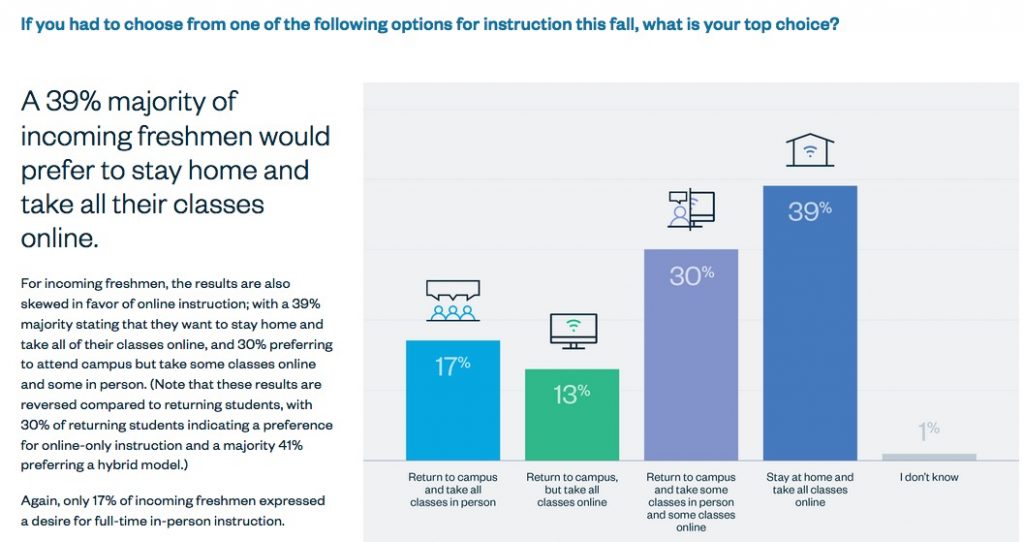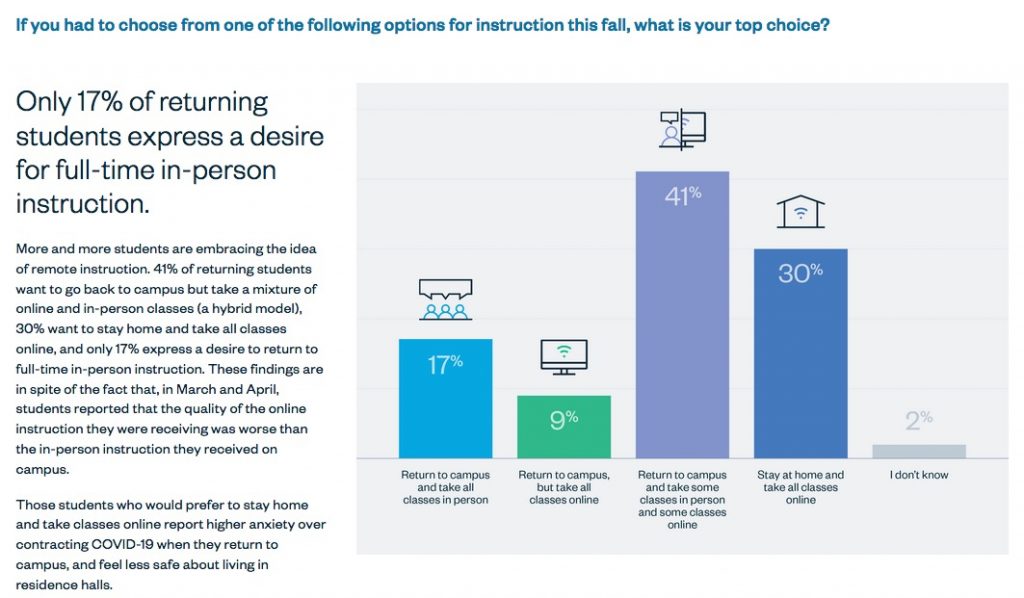College students are not eager to return to regular face-to-face classes amidst the ongoing coronavirus pandemic.
So reports Simpson Scarborough in its new National Student Survey on student attitudes related to how coronavirus is affecting their college education. Surveying 927 incoming college freshpeople and 905 returning students in late July, Simpson Scarborough found that only 17% of both groups want to return to full-time in-person instruction. About 70% of each cohort would prefer either fully online instruction or a hybrid model combining in-person and online classes. Interestingly, the incoming freshpeople—most of whom just went through the chaos of finishing high school in classes suddenly converted to online delivery—incline more toward all online classes than returning college students:


40% of incoming first-timers say they are likely or highly likely to not attend college at all this fall; that’s double the percentage reporting such attendance doubt in the spring. 16% of students who were on campus last school year say they are choosing not to go back; another 14% are still not sure.
While 74% of freshpeople and 76% of returning students say they are worried about catching coronavirus on campus this fall, only 56% of freshpeople and 63% of returners say they’ll always observe the six-foot rule indoors, and only 52% of freshpeople and 59% of returners say they’ll always avoid social gatherings and parties with more than ten people. Only 7% of freshpeople and 21% of returners say they trust their fellow students to follow campus guidelines to prevent the spread of the pandemic.
Sojourners Magazine lists 5 priorities for reopening schools:
1. Prioritize the needs of vulnerable students and families.
2. Stabilize public school budgets with emergency funding.
3. Provide all schools with more resources for in-person and/or distance learning.
4. Center the voices of students, families, and educators in decisions.
5. Respect and value educators and school leaders.
is.gd/Kj2y47
From a story in the NY Times:
Some districts in Massachusetts are hoping to provide in-person instruction for their most vulnerable students, while in Marin County, Calif., the school system will do so with small groups of special education students. A district near Denver that is starting the year fully remotely is allowing small groups of eligible elementary and middle school students to receive instruction in classrooms staffed by district employees and equipped with good internet access.
San Francisco, aiming for a broader reach, is planning to transform recreation facilities, libraries and community centers into “learning hubs,” where as many as 6,000 students out of a total 54,000 can go daily to complete their online schoolwork. Indianapolis will provide similar “hubs” for its homeless students, with school workers who can help them with assignments. New York last month announced a plan to offer free child care, saying it was looking for space for up to 50,000 students a day — about 5 percent of its total public school population.
is.gd/MTHkby
Peter Hutchinson, former superintendent of the Minneapolis Public Schools, has a radical plan to close education gaps between more affluent whites and others.
Hire the pandemic unemployed as tutors. Train and pay them using Covid-19 $. In addition, keep schools closed this year while educators rethink how to teach.
After Hurricane Katrina, New Orleans kept schools closed for a year while they rethought their school system, which had a poor record. Since they’ve reopened they’re doing much better.
SD has the Covid-19 $ that Kruel Kristi is sitting on. The state also has the unemployed who want to work. Now is a good time to recreate and strengthen a weak system.
Mississippi is always the state we try to compare ourselves with and for good reason, we both seem caught up into nothingness.
“On Monday morning, hundreds of sixth, seventh, and eighth graders filed through the doors at Grenada Middle School in north Mississippi.
Looking out of her classroom, math teacher Suzanne Alexander saw kids huddled together, giddy at being with friends for the first time in months. As she walked the halls, students she hadn’t seen since they moved to remote learning in March surprised her with big, enthusiastic hugs. When the bell rang at the end of the day, those same students hung out around classroom doors, waiting on friends—perhaps too intimidated, in normal middle school fashion, to be seen walking out alone.
It was, she said, a very typical first day of school. And that was the problem.” https://www.thedailybeast.com/mississippi-schools-are-a-coronavirus-disaster?via=newsletter&source=DDAfternoon
Have heart Daily Beast, put your optimistic pants on, we will soon be an equal to Mississippi, count on it.
Tutors. School helpers. What a perfect government jobs program. We do need to be careful that the people we are hire are trained and reliable around kids—not everyone is cut out for teaching—but we could find a lot of unemployed people who would provide welcome assistance to every school district in South Dakota.
149 school districts, 33,000 unemployed South Dakotans… assume half of those adults are qualified to tutor K-12. That’s 110 people you could put to work in each district… or, with 136,000 K-12 students, one tutor for every 8.2 kids. That decreased student-teacher ratio would be an awesome boost to learning.
So when everyone gets out of college, what will they do? They will have to look long and hard for a job and certainly not one in the airline world. While EB5 Short Rounds and the one who is lanky, cozy up to count their millions, thousands upon thousands of Americans await the door’s closing on their jobs.
“Virgin Atlantic files for bankruptcy protection as Covid continues to hurt airlines
Airline seeks protection under US’s bankruptcy code, allowing it to shield assets in the country” https://www.theguardian.com/business/2020/aug/14/us-airlines-layoffs-covid-19-support-delta-united-american
All of these airlines support travel into and out of South Dakota, and all have employees right here in the Sunshine State. But, our senators don’t think that it’s very important so they took a vacation for a month.
A fair comparison would tell us what those percentages were before Corona. My guess is that on-line learn gin that doesn’t require one to get up and face more rigorous engagement would have always been shunned for on-line options. My experience is that on-line classes are FAR less rigorous and taxing — pandemic or not.
I would also propose this theory: the COVID is getting college students to honestly evaluate what they hope to get from their college experience. As Jerry points out, maybe the whole “better job” scenario seems less likely to play out; maybe the college experience (i.e. Animal House/Revenge of the Nerds et al)) is not going to be part of their experience, so not worth the investment.
Exactly o, now if we toss in this equation, green jobs! We get to the promised land where people can actually work outside with social distancing along with a sense of accomplishment. I would say the same thing should apply to teachers if they are given the respect and the tools they need to work safely. But student loans man, there is a lot of slicing and dicing of those babies for profits for the big boys…they are gonna be hard to appease. Infrastructure makes the economy tick as it always has. No better way to put people to work than to give them a hammer and a future.
Science and mathematics geniuses, can make the world even better, they need school and a work environment to better us all.
Jerry: “Infrastructure makes the economy tick as it always has.” Unfortunately the US has based its economy on finance. We allowed/encouraged the profiteers to take manufacturing and labor overseas and built a house of straw that collapses every time we realize that the bubble we created doesn’t create work or “trickle down” benefits. We go from Ponzi scheme to Ponzi scheme for the 1% to make a cash grab. We ignore the history of the largest economic expansion in US history (and the tax rates that accompanied that expansion).
Infrastructure built South Dakota during the depression with the CCC Camps that got it all started. Before this trump virus is over, I think we will be seeing something like this again. Our bridges are falling down, our electrical grid needs rebuilding to accommodate the green economy. We have a lot to do, but we also have crackpot republicans who always always gum up the works, just as the did in the Depression.
I think it’s worth noting that another way to summarize the numbers is: “Majority of college students wants to return to campus” … for new students, the sections encompassing all return-to-campus options (hybrid, totally in-person, totally online) make up 61% of the survey responses; for returning students, it’s 70%.
Here’s one who wanted to return to campus
“An employee of Black Hills State University (BHSU) has tested positive for COVID-19, according to an email sent out to the campus community Friday which was obtained by the Journal.
The employee had visited the Student Union, and BHSU said the area is “being thoroughly cleaned.” Classes resume at BHSU on Wednesday.” Rapid City Journal 8.15.20
Yes, by all means, make that college thingy a thingy. By October, they will all be sick and dying for the dollar.